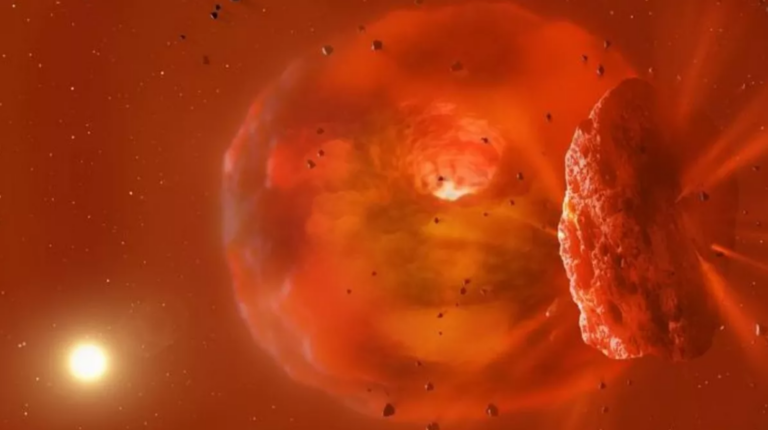Astronomers have successfully recorded the initial planet collision, resulting in a dust cloud that is now causing the parent star’s light to dim.
For the first time, an international group of astronomers observed the heat trace as two bands of heavyweights began warming up, then later watched a dust cloud move across the face of the parent star after it left its mark several years later.
The host, ASASSN-21qj, gained its designation from the network of telescopes that first picked up the decrease in its visible light in the skies. Added to this, the star was subsequently put under thorough observation by Stephen O’Meara, a network of amateur and professional astronomers, and the team under Dr Matthew Kenworthy at Leiden Observatory in the Netherlands over the next two years, on whom the task of tracking the star’s variations in brightness fell.
A paper of the category “A post-collision afterglow and transit of the debris cloud originating from a planetary collision” has been just published in Nature.
A scientist happened to casual post on a social media platform by an amateur researcher provided evidence that the brightness of the star decreasing in visible light had happened three years before the emission increased by half in the infrared wavelength. Due to this very greatly and unexpectedly for me.
“I shared the light curve of this star collected from ASASSN survey with fellow astronomers. At first, I startedobservation using a network of telescopes and observers. Instead, somebody on social media drew my attention to the infraredbrightening phenomenon preceding the optical fade over a thousand days. I became aware of the unusual nature of this occurs, and I decided to contact more astronomers to discuss the findings.”
Specifying the research, Richelle van Capelleveen, a graduate student from the Leiden University that cared out the study as part of her master’s thesis, reported, “We together with Honorable Kenworthy by analyzing the light curve understood the prospects of a planetary collision.”
The impact being the result of a collision of Saturn sized planets would be the most probable scenario and it was the more common process which gives an orbital movement of these planetary systems and therefore the infrared radiation detected by NEOWISE mission. Also, the dusty and smoky outflow from the event finally advanced to block the starlight approximately three years from the occurrence and thus reduce the star visible light brightness.
According to Dr. Simon Lock from the University of Bristol, UK and an author of the study, “The properties of the emitted glimmer such as temperature, size, and sustain are consistent with calculated values arising for collisions between the two ice giant exoplanets as was predicted by computational models.”
Animation of a planetary collision at ASASSN-21qj. What happens when two planets collide? Astronomers were fortunate enough to have unique views of the collision and aftermath of two Neptune sized planets colliding. When these ice giant planets crashed, they left behind a hot, loose ball of gas, dust and rocks, with an even hotter core. Over hundreds of years this will thin out around the orbit, the core will grow by accretion and moons may even form from the debris. Credit: Alice Hopkinson/Las Cumbres Observatory
We however think that these ‘caterpillars’ for the first time result from the planetary collision that released this glow, which is co-authored by Dr. Grant Kennedy (University of Warwick, United Kingdom), a co-author on the paper.
“It is such a unique chancey for us to get to understand for real the nature of these planets,” said Dr. Ludmila Carone of the Space Research Institute at the Austrian Academy of Sciences in Graz.
Usually, dense heavy genera, buried in the hydrogen and helium crust, are in the giant planets. Yet in this particular scenario the material is either moved away from the planetary centre or surfaced to contribute to the matter that went to shape the eventual outcome of the planet merger. Furthermore, Carone stated, ”Preliminary assessment shows a significant amount of water vapor to be released. Cooling of the post-impact body might reach 1000 degrees Kelvin”.
Finally, the material away from the posse could eventually stick together to make up a shield that would be made up of several moons circling around the new planet.
Do not forget to share your opinion with us to provide you with the best posts !





0 Comments